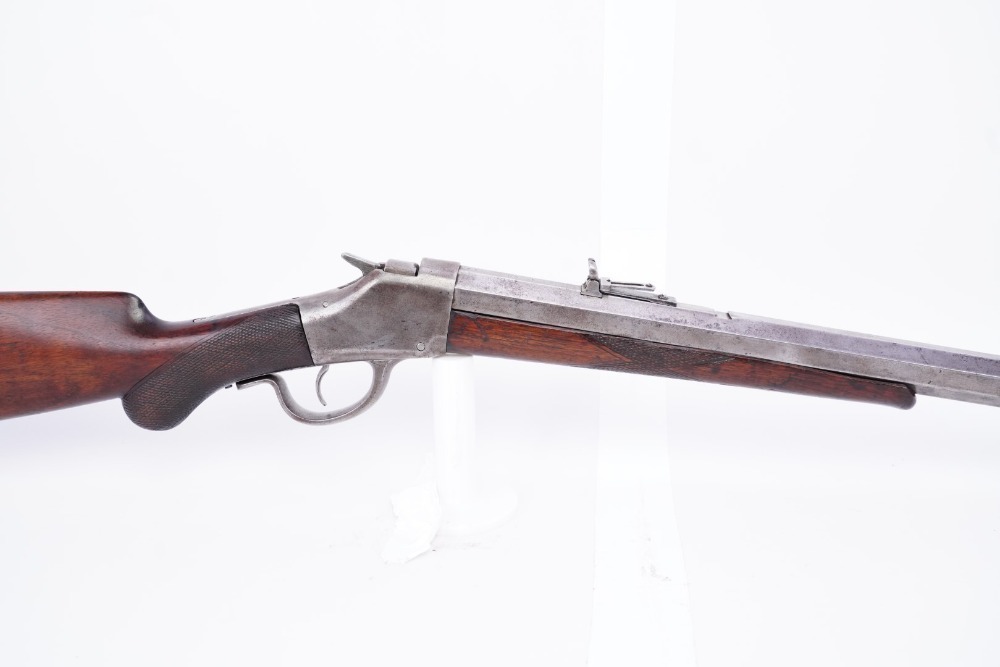
RARE BROWNING BROTHERS RIFLE 346 (WINCHESTER 1885 PREDECESSOR)
SOLD FOR: $6,545
Extremely Rare .45-70 Browning Brothers Single Shot Rifle #346 (Winchester 1885 Predecessor)
Make:Browning Brothers
Model:Single Shot Rifle
Serial Number:346
Year of Manufacture:Ca. 1879-1883
Caliber:The barrel is marked “45. 70.”, but we were not able to fully seat a .45-70 Gov’t cartridge in the chamber.
Action Type:Falling-Block, Single-Shot Rifle
Barrel Length:29 3/4”, Octagonal Sights/Optics: There is an empty dovetail at the front of the barrel for a front sight (none present). There is a folding ladder sight dovetailed to the rear of the barrel, presenting a “V”-notch buckhorn when down and having a “V”-notch slider on the ladder. There is an empty dovetail in front of the rear sight assembly. The top tang is drilled and tapped for a tang sight (none present). Stock Configuration and Condition: The stocks are two-piece checkered walnut with semi-pistol grip, slight schnabel tip on the forend, straight comb and steel crescent buttplate. The forend has a loss on the top-left edge at the front and a crack at the left-rear. There are a couple of small losses at the front edge of the wrist. There are scattered nicks, scuffs and scratches. The checkering is generally well defined. The LOP measures 13 1/4” from the front of the trigger to the back of the buttplate. The plate is in the white with some scattered wear and a tiny hole near the heel. Overall, the stocks are in Good-plus condition as Antique.
Type of Finish:None.
Finish Originality:It isn’t clear if the finish has been removed or if the surfaces were never finished. The barrel and receiver are serial-matching.
Bore Condition:The bore is gray with well defined rifling. There is scattered light erosion and minor pitting in the bore. In this writer’s opinion, the bore rates 5 or 6 out of 10. Most antique firearms have bores that will show erosion. This is not only due to age but to the use of black powder. When fired, black powder reacts corrosively. NRA Antique Firearm Conditions Standards are quite lenient for bores. In some cases, the NRA standards disregarded the bore’s condition for collectors’ firearms.
Overall Condition:The metal surfaces show scattered minor oxidation and some spots of minor erosion. There are light nicks, scuffs and scratches with a few more notable marks on the left receiver flat. The hammer spur appears to have been altered and does not have any checkering. The action shows operational wear. The screw heads are tooled with usable slots. The markings range from clear to worn, but legible. Overall, this rifle is in about Good condition as Antique (see Mechanics).
Mechanics:The action does not function correctly. We could not get the hammer to catch at full-cock and when the action is closed, the hammer falls to the fired position. We did not fire this rifle. As with all used firearms, thorough cleaning may be necessary to meet your maintenance requirements. Box, Paperwork, and Accessories: None.
Our Assessment:While Winchester has become nearly synonymous with “lever rifle” and John Browning is famous for, well, just about everything firearms-related in the 20th Century, the relationship between inventor John Moses Browning and the Winchester Repeating Arms Company began with a humble single shot rifle. Elegant in is simplicity, robust and reliable, the first 25 rifles produced by Browning Bros. sold out in a week. Their quality quickly became known and the rifles sold as fast as they could be made. Browning received a patent for his design in October of 1879 and set to work building rifles. In 1883, one of these rifles was purchased second hand by a Winchester salesman, Andrew McAusland, who found the design so interesting that he put the rifle in a crate and shipped it to the Winchester factory in New Haven. Shortly after it arrived, Thomas Bennett was on a train to Ogden to meet the Browning Brothers. During negotiations for the purchase of the Single Shot rifle’s patent, Browning happened to mention that he had a nearly completed design for a repeating rifle that could handle full-power loads like his single shot, and history was made. Bennett left Ogden with an agreement to purchase Browning’s patent, a dozen of his Single Shot rifles, and a relationship between Winchester and perhaps the most prolific firearms inventor in American history. Fewer than 600 rifles were produced by Browning before his patent was sold and this is number 346. The rifle shows honest wear for its age, most of these guns saw extensive use in the frontier for hunting. Its connection to Browning, likely having been handled by John himself during production, makes it a rare treat for collectors. Please see our photos and good luck!

